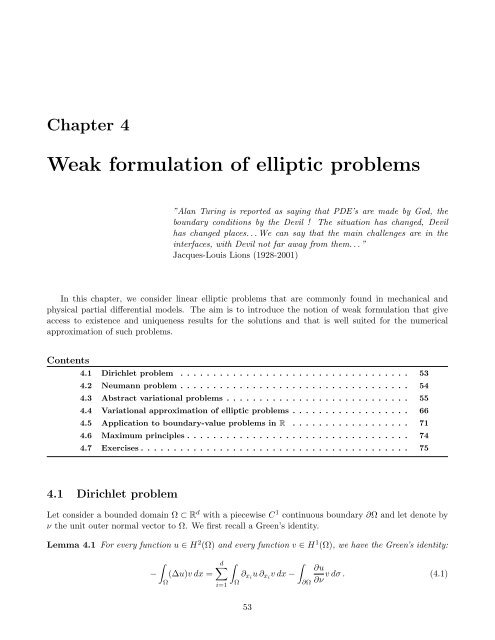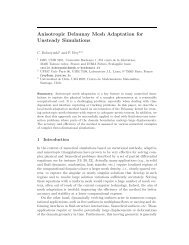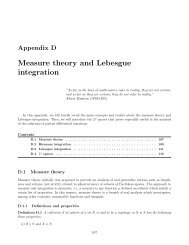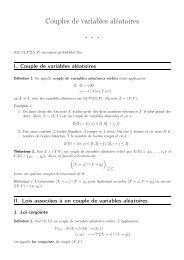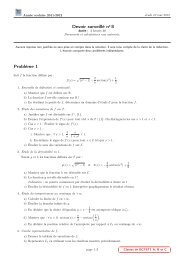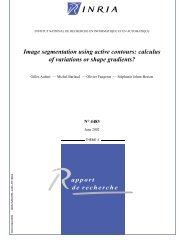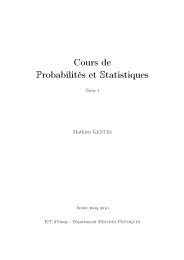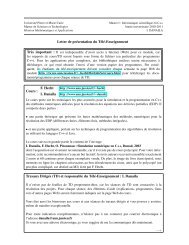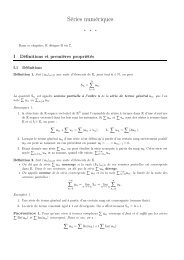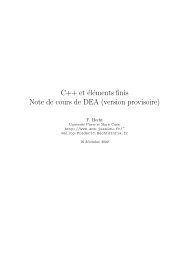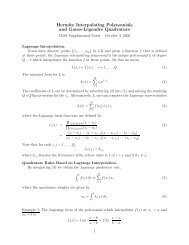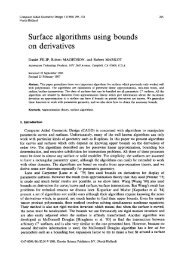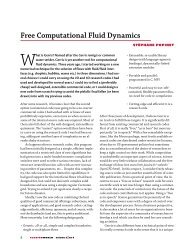Chapter 4. Weak formulation of elliptic problems
Chapter 4. Weak formulation of elliptic problems
Chapter 4. Weak formulation of elliptic problems
You also want an ePaper? Increase the reach of your titles
YUMPU automatically turns print PDFs into web optimized ePapers that Google loves.
<strong>Chapter</strong> 4<br />
<strong>Weak</strong> <strong>formulation</strong> <strong>of</strong> <strong>elliptic</strong> <strong>problems</strong><br />
”Alan Turing is reported as saying that PDE’s are made by God, the<br />
boundary conditions by the Devil ! The situation has changed, Devil<br />
has changed places. . . We can say that the main challenges are in the<br />
interfaces, with Devil not far away from them. . . ”<br />
Jacques-Louis Lions (1928-2001)<br />
In this chapter, we consider linear <strong>elliptic</strong> <strong>problems</strong> that are commonly found in mechanical and<br />
physical partial differential models. The aim is to introduce the notion <strong>of</strong> weak <strong>formulation</strong> that give<br />
access to existence and uniqueness results for the solutions and that is well suited for the numerical<br />
approximation <strong>of</strong> such <strong>problems</strong>.<br />
Contents<br />
<strong>4.</strong>1 Dirichlet problem . . . . . . . . . . . . . . . . . . . . . . . . . . . . . . . . . . . 53<br />
<strong>4.</strong>2 Neumann problem . . . . . . . . . . . . . . . . . . . . . . . . . . . . . . . . . . . 54<br />
<strong>4.</strong>3 Abstract variational <strong>problems</strong> . . . . . . . . . . . . . . . . . . . . . . . . . . . . 55<br />
<strong>4.</strong>4 Variational approximation <strong>of</strong> <strong>elliptic</strong> <strong>problems</strong> . . . . . . . . . . . . . . . . . . 66<br />
<strong>4.</strong>5 Application to boundary-value <strong>problems</strong> in R . . . . . . . . . . . . . . . . . . 71<br />
<strong>4.</strong>6 Maximum principles . . . . . . . . . . . . . . . . . . . . . . . . . . . . . . . . . . 74<br />
<strong>4.</strong>7 Exercises . . . . . . . . . . . . . . . . . . . . . . . . . . . . . . . . . . . . . . . . . 75<br />
<strong>4.</strong>1 Dirichlet problem<br />
Let consider a bounded domain Ω ⊂ R d with a piecewise C 1 continuous boundary ∂Ω and let denote by<br />
ν the unit outer normal vector to Ω. We first recall a Green’s identity.<br />
Lemma <strong>4.</strong>1 For every function u ∈ H 2 (Ω) and every function v ∈ H 1 (Ω), we have the Green’s identity:<br />
�<br />
− (∆u)v dx =<br />
Ω<br />
d�<br />
�<br />
i=1<br />
∂xi<br />
Ω<br />
53<br />
�<br />
u ∂xiv dx −<br />
∂Ω<br />
∂u<br />
v dσ . (<strong>4.</strong>1)<br />
∂ν
54 <strong>Chapter</strong> <strong>4.</strong> <strong>Weak</strong> <strong>formulation</strong> <strong>of</strong> <strong>elliptic</strong> <strong>problems</strong><br />
We consider the following model problem:<br />
Given a real-valued function f ∈ L 2 (Ω), find a function u defined in Ω solving<br />
−∆u = f in Ω (<strong>4.</strong>2)<br />
u = 0 on ∂Ω . (<strong>4.</strong>3)<br />
Suppose the solution u is sufficiently smooth, for example u ∈ H2 (Ω). Then, we can multiply each side<br />
<strong>of</strong> the equation (<strong>4.</strong>2) by a test function v ∈ H1 0 (Ω) and integrate on Ω to obtain:<br />
�<br />
�<br />
− (∆u)v dx = fv dx .<br />
Thanks to Green’s identity (<strong>4.</strong>1) and by noticing that v|∂Ω = 0, we obtain:<br />
∀v ∈ H 1 0 (Ω) ,<br />
Ω<br />
d�<br />
�<br />
i=1<br />
∂xi<br />
Ω<br />
Ω<br />
u ∂xi v dx =<br />
�<br />
Ω<br />
fv dx . (<strong>4.</strong>4)<br />
The specific boundary conditions and the Theorem 2.21 yield to conclude that the solution u <strong>of</strong> the<br />
problem (<strong>4.</strong>4) is such that:<br />
u ∈ H 1 0 (Ω)<br />
and the initial problem is now replaced by the following problem:<br />
Given a function f ∈ L2 (Ω), find a function u ∈ H1 0 (Ω) such that identity (<strong>4.</strong>4) holds.<br />
This is the weak <strong>formulation</strong> <strong>of</strong> the Dirichlet problem (<strong>4.</strong>2).<br />
We have seen that any solution u <strong>of</strong> the Dirichlet problem (<strong>4.</strong>2), sufficiently smooth, is solution <strong>of</strong><br />
the problem (<strong>4.</strong>4). Conversely, a solution u ∈ H1 0 (Ω) is a solution <strong>of</strong> the problem (<strong>4.</strong>4) if and only if:<br />
∀ϕ ∈ D(Ω) ,<br />
d�<br />
�<br />
i=1<br />
∂xi<br />
Ω<br />
u ∂xi ϕ dx =<br />
�<br />
Ω<br />
fϕ dx ,<br />
since H1 0 (Ω) is the closure <strong>of</strong> D(Ω) in H1 (Ω) (cf. Definition 2.14). Consequently, if u satisfies the equation<br />
(<strong>4.</strong>4), then the initial equation −∆u = f is satisfied on Ω in the distributional sense and since f ∈ L2 (Ω),<br />
this equation is verified in L2 (Ω), thus almost everywhere in Ω. Finally, u ∈ H1 0 (Ω) leads to satisfy the<br />
boundary condition according to the trace theorem on the boundary ∂Ω.<br />
<strong>4.</strong>2 Neumann problem<br />
Let consider an open bounded domain Ω ⊂ R d with a piecewise C 1 continuous boundary ∂Ω. We now<br />
focus on the following problem:<br />
Given a function f ∈ L 2 (Ω), find a function u defined on Ω solving<br />
−∆u + u = f in Ω (<strong>4.</strong>5)<br />
∂u<br />
∂ν<br />
= 0 on ∂Ω . (<strong>4.</strong>6)<br />
Suppose the solution u ∈ H2 (Ω). Then, following the same procedure as for the Dirichlet problem, we<br />
obtain:<br />
∀v ∈ H 1 (Ω) ,<br />
d�<br />
�<br />
� �<br />
∂xiu ∂xiv dx + uv dx = fv dx .<br />
Ω<br />
Ω<br />
Ω<br />
(<strong>4.</strong>7)<br />
i=1
<strong>4.</strong>3. Abstract variational <strong>problems</strong> 55<br />
The original boundary-value problem is then replaced by the following:<br />
Given a function f ∈ L 2 (Ω), find a solution u ∈ H 1 (Ω) verifying equation (<strong>4.</strong>7).<br />
Any sufficiently smooth solution u <strong>of</strong> the Neumann problem is solving the previous problem. Conversely,<br />
if u ∈ H 1 (Ω) solves the problem (<strong>4.</strong>7), we have<br />
∀ϕ ∈ D(Ω) ,<br />
d�<br />
�<br />
i=1<br />
∂xi<br />
Ω<br />
�<br />
u ∂xiϕ dx + uϕ dx =<br />
Ω<br />
�<br />
Ω<br />
fϕ dx ,<br />
and since u and f are L 2 (Ω) functions, the initial equation −∆u + u = f is satisfied in the distributional<br />
sense, in L 2 (Ω). When u ∈ H 2 (Ω), we can show, using the Green’s formula, that equation <strong>4.</strong>7 is equivalent<br />
to the initial equation and that:<br />
∀v ∈ H 1 (Ω) ,<br />
�<br />
∂Ω<br />
∂u<br />
v dσ = 0 ,<br />
∂ν<br />
and, since the trace space on Ω is dense in L2 (Ω), we have:<br />
∀w ∈ L 2 (∂Ω) ,<br />
�<br />
∂u<br />
w dσ = 0 ,<br />
∂ν<br />
which leads to the Neumann boundary condition in the L 2 (Ω) sense. Any smooth solution <strong>of</strong> equation<br />
(<strong>4.</strong>7) is thus solving the initial Neumann problem.<br />
<strong>4.</strong>3 Abstract variational <strong>problems</strong><br />
The previous examples fit in a general abstract framework that is well suited for the resolution <strong>of</strong> a large<br />
class <strong>of</strong> boundary value <strong>elliptic</strong> <strong>problems</strong>. To this end, we consider:<br />
(i) a Hilbert space V on R, endowed with a norm � · �,<br />
(ii) a bilinear form a defined and continuous on V × V , i.e. such that there exists a constant M > 0<br />
such that:<br />
∀u ∈ V , ∀v ∈ V , a(u, v) ≤ M�u� �v� ,<br />
(iii) a linear form l continuous on V , i.e. an element l <strong>of</strong> the topological dual space V ′ = L(V, R) <strong>of</strong> V<br />
endowed with the dual norm<br />
l(v)<br />
�l�V ′ = sup<br />
v∈V �v�<br />
v�=0<br />
.<br />
Then, we consider the general variational problem:<br />
�<br />
′<br />
Given l ∈ V , find u ∈ V solving the problem<br />
(P)<br />
∀v ∈ V , a(u, v) = l(v)<br />
As such, this problem is certainly not well-posed. We will give a sufficient condition on the bilinear form<br />
a to have a unique solution. We first introduce a definition.<br />
Definition <strong>4.</strong>1 The problem (P) is said to be well-posed if there is a unique solution to this problem<br />
and if the following linear stability property is satisfied:<br />
∂Ω<br />
∃C > 0 , ∀l ∈ V ′ , �u� ≤ C �l�V ′ .<br />
The objective is now to determine if and when a variational problem is well-posed. Two fundamental<br />
results will help us to solve this question.<br />
(<strong>4.</strong>8)
56 <strong>Chapter</strong> <strong>4.</strong> <strong>Weak</strong> <strong>formulation</strong> <strong>of</strong> <strong>elliptic</strong> <strong>problems</strong><br />
<strong>4.</strong>3.1 The Lax-Milgram theorem<br />
Definition <strong>4.</strong>2 The bilinear form a(·, ·) is said to be V -<strong>elliptic</strong> if there exists a constant α > 0 such that<br />
∀v ∈ V , a(v, v) ≥ α�v� 2 .<br />
Theorem <strong>4.</strong>1 (Lax-Milgram lemma) Let V be a Hilbert space, a ∈ L(V × V, R) be a bilinear form,<br />
and l ∈ V ′ be a linear form continuous on V . Then, under the condition that:<br />
(c0) the bilinear form a is continuous and V -<strong>elliptic</strong> with constant α,<br />
the problem P is well-posed (i.e. has a unique solution) and we have the estimate:<br />
∀l ∈ V ′ , �u�V ≤ 1<br />
�l�V ′ ,<br />
α<br />
(i.e. the mapping u ↦→ l is an isomorphism <strong>of</strong> V on V ′ ).<br />
Pro<strong>of</strong>. Since the linear form l is continuous on V , the Riesz representation theorem asserts the existence <strong>of</strong> a<br />
unique element wl ∈ V such that<br />
∀v ∈ V , l(v) = 〈wl, v〉 .<br />
This relation defines a linear one-to-one isometric mapping l ↦→ wl from V ′ on V . Similarly, u being fixed in V ,<br />
the linear form v ↦→ a(u, v) is continuous on V . It is thus an isomorphism. Invoking the representation theorem<br />
again, there exists a unique element w ∈ V such that:<br />
∀v ∈ V , a(u, v) = 〈w, v〉 ,<br />
and we pose w = Au. We claim that A : V → V is a bounded continuous linear operator. It follows that the<br />
problem (P) is equivalent to finding u ∈ V solving<br />
Au = wl .<br />
The existence and uniqueness are obtained by establishing that the linear operator A is a bijective mapping from<br />
V to V . A being continuous, the inverse A −1 is continuous from V to V .<br />
(i) A is an injection, i.e. Ker(A) = {0}. Actually, since a is V -<strong>elliptic</strong>, we have<br />
and thus,<br />
This shows that A is an injection, since:<br />
thus v = 0 and, consequently, Ker(A) = {0}.<br />
∀v ∈ V , α�v� 2 ≤ a(v, v) = 〈Av, v〉 ≤ �Av� �v� ,<br />
∀v ∈ V , �Av� ≥ α�v� .<br />
v ∈ Ker(A) ⇔ Av = 0 ⇒ 〈Av, v〉 = 0<br />
(ii) A is a surjection, i.e. ImA = R(A) = V . We need to show that R(A) is closed and dense in V .<br />
Let consider w ∈ R(A) (the closure <strong>of</strong> R(A) in V ) and let (Avm)m∈N be a sequence <strong>of</strong> R(A) that converges<br />
to w in V . We have:<br />
�Avm − Avn� ≥ α�vm − vn�<br />
such that (vm) is a Cauchy sequence in the Hilbert space V : it converges to an element v ∈ V and (Avm)<br />
converges to Av, since A is continuous. Hence, we have:<br />
and we can conclude that R(A) is closed in V .<br />
Now, let consider v0 ∈ (R(A)) ⊥ , we have<br />
w = Av ∈ R(A) ,<br />
α�v0� 2 ≤ a(v0, v0) = 〈Av0, v0〉 = 0 ,<br />
anf thus v0 = 0. This shows that (R(A)) ⊥ is reduced to {0} and thus A is a surjection.
<strong>4.</strong>3. Abstract variational <strong>problems</strong> 57<br />
The linear operator A is a one-to-one mapping from V to V . From the V -<strong>elliptic</strong>ity property, we deduce<br />
and hence that A −1 is continuous. By noticing that:<br />
∀v ∈ V , �A −1 v� ≤ 1<br />
�v� ,<br />
α<br />
〈wl, v〉<br />
�wl� = sup<br />
v∈V �v�<br />
v�=0<br />
we obtain that the solution u to the problem (P) is such that:<br />
l(v)<br />
= sup<br />
v∈V �v�<br />
v�=0<br />
= �l�∗ ,<br />
�u� = �A −1 wl� ≤ 1 1<br />
�wl� = �l�V ′ ,<br />
α α<br />
and the result follows. �<br />
When the bilinear form a(·, ·) is symmetric and positive, the problem (P) can be interpreted as a<br />
minimization problem.<br />
Theorem <strong>4.</strong>2 Consider a Hilbert space V , a ∈ L(V × V, R) and l ∈ V ′ . Suppose the bilinear form a(·, ·)<br />
is symmetric and positive:<br />
∀u, v ∈ V , a(u, v) = a(v, u) and ∀u ∈ V , a(u, u) ≥ 0 .<br />
Then, u is solution <strong>of</strong> the problem (P) if and only if u minimizes on V the functional<br />
i.e. J(u) = inf<br />
v∈V J(v).<br />
∀v ∈ V , J(v) = 1<br />
a(v, v) − l(v) ,<br />
2<br />
Pro<strong>of</strong>. Suppose u is solution <strong>of</strong> the problem (P). A direct calculation gives:<br />
∀v ∈ V , J(v) = J(u) + a(u, v − u) − l(v − u) + 1<br />
a(v − u, v − u)<br />
2<br />
= J(u) + 1<br />
a(v − u, v − u)<br />
2<br />
≥ J(u) ,<br />
which attests that u minimizes the function J on V . Conversely, let consider v ∈ V , λ ∈]0, 1] and we pose<br />
w = u + λv. A direct calculation gives:<br />
Dividing by λ and letting λ → 0 yields<br />
J(w) − J(u) = λ (a(u, v) − l(v)) + λ2<br />
a(v, v) ≥ 0 .<br />
2<br />
∀v ∈ V , a(u, v) ≥ l(v) .<br />
Substituting v by −v yields to the equality and thus to conclude that u is solution <strong>of</strong> the problem (P). �<br />
Remark <strong>4.</strong>1 (i) When the bilinear form a(·, ·) is symmetric, the problem (P) corresponds to the minimization<br />
<strong>of</strong> a quadratic functional on a Hilbert space V , which is the abstract <strong>formulation</strong> <strong>of</strong><br />
numerous <strong>problems</strong> in calculus <strong>of</strong> variations. This explains why (P) is called a variational problem.
58 <strong>Chapter</strong> <strong>4.</strong> <strong>Weak</strong> <strong>formulation</strong> <strong>of</strong> <strong>elliptic</strong> <strong>problems</strong><br />
(ii) When the bilinear form a(·, ·) is symmetric and V -<strong>elliptic</strong>, the Lax-Milgram theorem indicates that<br />
the optimization problem infv∈V J(v) has a unique solution. The V -<strong>elliptic</strong>ity <strong>of</strong> a can be seen as a<br />
property <strong>of</strong> strong convexity <strong>of</strong> the functional J.<br />
(iii) In many applications, the functional J corresponds to an energy (cf. the deformation <strong>of</strong> an elastic<br />
membrane).<br />
Example <strong>4.</strong>1 We consider the Dirichlet problem (<strong>4.</strong>2). Its variational (weak) <strong>formulation</strong> is that <strong>of</strong><br />
problem (P), if we pose<br />
V = H 1 0 (Ω) endowed with �v� = �v�1,Ω ,<br />
a(u, v) =<br />
d�<br />
�<br />
i=1<br />
�<br />
l(v) =<br />
Ω<br />
∂xi<br />
Ω<br />
fv dx .<br />
u ∂xi v dx ,<br />
It is easy to see that the bilinear form a(·, ·) (resp. the linear form l(·)) is continuous on H1 0 (Ω) × H1 0 (Ω)<br />
(resp. on H1 0 (Ω)) since we have<br />
where | · |1,Ω denotes the semi-norm on H 1 (Ω):<br />
a(u, v) ≤ |u|1,Ω|v|1,Ω ≤ �u�1,Ω �v�1,Ω<br />
l(v) ≤ �f�0,Ω�v�0,Ω ≤ �f�0,Ω �v�1,Ω ,<br />
|v|1,Ω =<br />
� d�<br />
i=1<br />
�∂xi v�2<br />
0,Ω<br />
Furthermore, since Ω is an open bounded subset <strong>of</strong> Rd , the bilinear form a(·, ·) is H1 0 (Ω)-<strong>elliptic</strong>, as we<br />
have:<br />
∀v ∈ H 1 0 (Ω) , a(v, v) ≥<br />
�1/2<br />
.<br />
1<br />
1 + C 2 �v�2 1,Ω ,<br />
thanks to Poincaré’s inequality. According to Lax-Milgram theorem, there exists a unique function u ∈<br />
H1 0 (Ω) such that<br />
d�<br />
�<br />
�<br />
u ∂xiv dx = fv dx ,<br />
that is precisely the form (<strong>4.</strong>4).<br />
∀v ∈ H 1 0 (Ω) ,<br />
i=1<br />
∂xi<br />
Ω<br />
Remark <strong>4.</strong>2 We could have considered the Dirichlet boundary-value problem in the following <strong>formulation</strong>:<br />
given f ∈ H −1 (Ω), find u such that<br />
−∆u = f in Ω and u = 0 on ∂Ω .<br />
As the right-hand side is not smooth, we will not look for a classical solution (u ∈ C2 (Ω)) for this problem.<br />
Since ∆u is in H−1 (Ω), it seems reasonable to look for u ∈ H1 (Ω) and thus in H1 0 (Ω) because <strong>of</strong> the<br />
boundary condition. Let consider v ∈ H1 0 (Ω). The density <strong>of</strong> D(Ω) in H1 0 (Ω) leads to write:<br />
∀v ∈ H 1 0 (Ω) , ∀w ∈ H 1 (Ω) , 〈−∆w, v〉 = 〈∇w, ∇v〉 L 2 (Ω) .<br />
Ω
<strong>4.</strong>3. Abstract variational <strong>problems</strong> 59<br />
Hence, if u is a solution <strong>of</strong> the problem in H1 (Ω), then u is also a solution <strong>of</strong> the weak <strong>formulation</strong>: find<br />
u ∈ H1 0 (Ω) such that<br />
∀v ∈ H 1 0 (Ω) , 〈∇u, ∇v〉 L2 (Ω) = 〈f, v〉 .<br />
Conversely, suppose u is a solution <strong>of</strong> the problem above and consider v = ϕ ∈ D(Ω):<br />
hence, in the distributional sense:<br />
∀ϕ ∈ D(Ω) , 〈f, v〉 = 〈∇u, ∇ϕ〉 L 2 (Ω) = −〈∆u, ϕ〉 ,<br />
−∆u = f ,<br />
and since f ∈ H −1 (Ω), this equality is posed in H −1 (Ω). To solve this problem, we have to show that<br />
the weak <strong>formulation</strong> has a unique solution. This can be achieved by invoking Lax-Milgram theorem with<br />
V = H1 0 (Ω), V ′ = H−1 (Ω), a(u, v) = 〈∇u, ∇v〉 L2 (Ω) and l(v) = 〈f, v〉. H1 0 (Ω) is a Hilbert space endowed<br />
with the norm |·|1,Ω (equivalent to the norm �·�1,Ω thanks to Poincaré’s inequality) and 〈∇u, ∇v〉 L2 (Ω) is<br />
the inner product associated with this norm. Hence, the hypothesis <strong>of</strong> Lax-Milgram theorem are satisfied<br />
for M = 1 and α = 1, the problem has a unique solution and moreover,<br />
|u|1,Ω ≤ �f�−1,Ω . (<strong>4.</strong>9)<br />
If the function f has more regularity, the solution u will also have more regularity. For instance, if<br />
f ∈ L 2 (Ω), then u ∈ H 2 (Ω) since ∆u ∈ L 2 (Ω) and all the second derivatives are in L 2 (Ω).<br />
Definition <strong>4.</strong>3 An open set Ω is said to be Lipschitz (or Lipschitz continuous) if it is bounded and if in<br />
the vicinity <strong>of</strong> any point <strong>of</strong> its boundary, the boundary can be locally parametrized by a Lipschitz function<br />
ϕ, the domain being located on one side <strong>of</strong> the boundary.<br />
An open set Ω is said to be <strong>of</strong> class C m,1 if the Lipschitz function ϕ can be replaced by a C m -continuous<br />
function, whose derivatives <strong>of</strong> order m are Lipschitz continuous.<br />
Theorem <strong>4.</strong>3 1. Suppose Ω is <strong>of</strong> class C 1,1 or Ω is a convex polygon (polyhedron). Then, the operator<br />
−∆ is an isomorphism <strong>of</strong> H 2 (Ω) ∩ H 1 0 (Ω) on L2 (Ω).<br />
2. Suppose Ω is an arbitrary polygon in R 2 . For each t such that 1 < t ≤ 4/3, the operator −∆ is an<br />
isomorphism <strong>of</strong> W 2,t (Ω) ∩ H 1 0 (Ω) on Lt (Ω).<br />
3. Suppose Ω is a Lipschitz polyhedron in R 3 . The operator −∆ is an isomorphism <strong>of</strong> H 3/2 (Ω)∩H 1 0 (Ω)<br />
on L 3/2 (Ω).<br />
Then, under the Lax-Milgram hypothesis, there exists a constant C such that<br />
∀u ∈ H 2 (Ω) ∩ H 1 0 (Ω) , �u�2,Ω ≤ C �∆u�0,Ω .<br />
Remark <strong>4.</strong>3 This result is not true if Ω is a polygon with a concave corner, i.e. there exists right-hand<br />
side terms f for which the solution <strong>of</strong> the Dirichlet problem is not in H 2 (Ω).<br />
<strong>4.</strong>3.2 Non-homogeneous Dirichlet conditions<br />
Now, we consider the non-homogeneous Dirichlet problem:<br />
Given f ∈ H −1 (Ω) and given g ∈ H 1/2 (∂Ω), find u ∈ H 1 (Ω) such that:<br />
−∆u = f in Ω<br />
u = g on ∂Ω .<br />
(<strong>4.</strong>10)
60 <strong>Chapter</strong> <strong>4.</strong> <strong>Weak</strong> <strong>formulation</strong> <strong>of</strong> <strong>elliptic</strong> <strong>problems</strong><br />
Notice that this problem has at most one solution. The aim is to retrieve a homogeneous problem that<br />
we can solve. The trace theory indicates that if ∂Ω is C 1 -continuous and if g ∈ H 1/2 (∂Ω) then there<br />
exists a function ug ∈ H 1 (Ω) such that γ0(ug) = g. In other words, the trace <strong>of</strong> ug on ∂Ω is the function<br />
g. This function ug is called a Dirichlet lift <strong>of</strong> g in Ω. We pose u0 = u − ug and our problem is equivalent<br />
to the homogeneous problem:<br />
Given f ∈ H −1 (Ω) and g ∈ H 1/2 (∂Ω), find u0 ∈ H 1 (Ω) such that<br />
−∆u0 = f + ∆ug in Ω<br />
u0 = 0 on ∂Ω .<br />
(<strong>4.</strong>11)<br />
Notice first that if ug ∈ H 1 (Ω) then ∆ug ∈ D ′ (Ω) but ∆ug /∈ L 2 (Ω). However, since ∆ug ∈ H −1 (Ω), this<br />
problem has a unique solution u0. Hence, u = u0 + ug is solution <strong>of</strong> the initial problem (<strong>4.</strong>10) that has at<br />
most one solution, then this solution is unique and is independent <strong>of</strong> the Dirichlet lift function ug. Since,<br />
the inequality (<strong>4.</strong>9) leads to write:<br />
Hence, for every lift ug <strong>of</strong> the function g,<br />
and then<br />
�∆ug�−1,Ω ≤ �∇ug�0,Ω = |ug|1,Ω ,<br />
|u0|1,Ω ≤ �f�−1,Ω + �∆ug�−1,Ω ≤ �f�−1,Ω + |ug|1,Ω .<br />
�u�1,Ω ≤ �u0�1,Ω + �ug�1,Ω ≤ (C 2 + 1) 1/2 �f�−1,Ω + ((C 2 + 1) 1/2 + 1)�ug�1,Ω ,<br />
�u�1,Ω ≤ (C 2 + 1) 1/2 �f�−1,Ω + ((C 2 + 1) 1/2 + 1) inf<br />
γ0v=g �v�1,Ω<br />
≤ (C 2 + 1) 1/2 �f�−1,Ω + ((C 2 + 1) 1/2 + 1)�g� H 1/2 (∂Ω) .<br />
Finally, we enounce several results that summarize and extend the previous remarks.<br />
Theorem <strong>4.</strong>4 (interior regularity) Let consider Ω ⊂ Rd an open bounded domain such that the<br />
Dirichlet problem is well-posed. We note u ∈ H1 0 (Ω) the weak solution. Then, if f ∈ Hm certain m ≥ 0, then u ∈ H<br />
loc (Ω) for a<br />
m+2<br />
loc (Ω), where<br />
H m loc (Ω) = {u ∈ D′ (Ω) , ϕu ∈ H m (R d ) , ∀ϕ ∈ D(Ω)} .<br />
Theorem <strong>4.</strong>5 (global regularity) Let u be the weak solution <strong>of</strong> the Dirichlet problem (??). If ∂Ω<br />
is bounded and C m+2 -continuous (or if Ω = R d +) and if f ∈ H m (Ω) (m ≥ 0), then u ∈ H m+2 (Ω).<br />
Furthermore, there exsts a constant Cm > 0 (independent <strong>of</strong> u and f) such that:<br />
�u� H m+2 (Ω) ≤ Cm �f� H m (Ω) .<br />
Theorem <strong>4.</strong>6 If Ω is C 1 -continuous and bounded in one direction, the non-homogeneous Dirichlet problem<br />
(<strong>4.</strong>10) admits:
<strong>4.</strong>3. Abstract variational <strong>problems</strong> 61<br />
1. A unique weak solution u ∈ H 1 (Ω) if f ∈ L 2 (Ω) and g ∈ H 1/2 (∂Ω). The solution u is such that:<br />
�u� H 1 (Ω) ≤ C (�f� L 2 (Ω) + �g� H 1/2 (∂Ω) ) ,<br />
where the constant C is independent from u, f and g.<br />
2. interior regularity: if f ∈ Hm loc (Ω) then u ∈ Hm+2<br />
loc (Ω) for every m ∈ N.<br />
3. global regularity: if ∂Ω is bounded and <strong>of</strong> class C m+2 or if ∂Ω = R d +, f ∈ H m (Ω) and g ∈<br />
H m+3/2 (∂Ω) (m ∈ N) then u ∈ H m+2 (Ω). Furthermore, we have the following estimate:<br />
�u� H m+2 (Ω) ≤ C (�f� H m (Ω) + �g� H m+3/2 (∂Ω) ) ,<br />
where the constant C is independent from u, f and g.<br />
Pro<strong>of</strong>. The trace theory indicates that if ∂Ω is C 1 -continuous and if g ∈ H 1/2 (∂Ω) then there exists a function<br />
ug ∈ H 1 (Ω) such that γ0(ug) = g. We consider the problem (<strong>4.</strong>11) as being posed in D ′ (Ω). Hence, we have:<br />
〈−∆u0, ϕ〉D ′ ×D = 〈f, ϕ〉D ′ ×D + 〈∆ug, ϕ〉D ′ ×D , ∀ϕ ∈ D(Ω) .<br />
By definition <strong>of</strong> the derivation <strong>of</strong> distributions, we have:<br />
d�<br />
i=1<br />
〈∂xi u0, ∂xi ϕ〉D ′ ×D = 〈f, ϕ〉D ′ ×D −<br />
All the terms being L 2 (Ω) functions, we can rewrite the previous identity as:<br />
�<br />
∇u0 · ∇ϕ dx =<br />
Ω<br />
and the weak <strong>formulation</strong> <strong>of</strong> problem (<strong>4.</strong>11) becomes:<br />
Find u0 ∈ H 1 0 (Ω) such that:<br />
�<br />
∇u0 · ∇w dx =<br />
Ω<br />
�<br />
�<br />
Ω<br />
Ω<br />
d�<br />
i=1<br />
∂xi ug, ∂xi ϕ〉D ′ ×D , ∀ϕ ∈ D(Ω) .<br />
�<br />
fv dx − ∇ug · ∇ϕ dx , ∀ϕ ∈ D(Ω) ,<br />
Ω<br />
fv dx −<br />
�<br />
∇ug · ∇w dx ,<br />
Ω<br />
∀w ∈ H 1 0 (Ω) .<br />
In order to involve the Lax-Milgram theorem, we define the bilinear form a(v, w) = �<br />
Ω ∇u0 · ∇w dx and the linear<br />
form l(w) = � �<br />
fw x − Ω Ω ∇ug · ∇w dx. The linear form l is continuous since we have the estimate:<br />
If we pose C = max(�f� L 2 (Ω), �∇ug� L 2 (Ω)), we obtain:<br />
|l(w)| ≤ �f� L 2 (Ω)�w� L 2 (Ω) + �∇ug� L 2 (Ω)�∇w� L 2 (Ω) .<br />
|l(w)| ≤ C�w� H 1 (Ω) , ∀w ∈ H 1 0 (Ω) .<br />
The Lax-Milgram theorem states that there exists a constant C > 0 such that:<br />
�u0� H 1 (Ω) ≤ C(�f� L 2 (Ω) + �∇ug� L 2 (Ω)) ≤ C(�f� L 2 (Ω) + �ug� H 1 (Ω)) ≤ C(�f� L 2 (Ω) + �g� H 1/2 (Ω)) .<br />
Since u = u0 + ug, it is easy to obtain the same type <strong>of</strong> estimate for the function u ∈ H 1 (Ω). The theorem <strong>4.</strong>4<br />
gives the second item. Finally, if Ω is C m+2 -continuous and if g ∈ H m+3/2 (∂Ω), we can chose ug ∈ H m+2 (Ω) such<br />
that �ug� H m+2 (Ω) ≤ 1/2�g� H m+3/2 (Ω). Then, ∆ug ∈ L 2 (Ω) and theorem <strong>4.</strong>5 can be invoked to conclude. �
62 <strong>Chapter</strong> <strong>4.</strong> <strong>Weak</strong> <strong>formulation</strong> <strong>of</strong> <strong>elliptic</strong> <strong>problems</strong><br />
<strong>4.</strong>3.3 The Nečas theorem<br />
Now, we introduce an important theoretical result due to the Czech mathematician Nečas (1929-).<br />
Theorem <strong>4.</strong>7 (Nečas) Let V and W be two Hilbert spaces. We consider the abstract problem<br />
Given l ∈ V ′ , find u ∈ W such that : a(u, v) = l(v) , ∀v ∈ V ,<br />
where a is a bilinear continuous form on W × V and f is a linear form on V . This problem is well-posed<br />
if and only if:<br />
(c1) there exists a constant α > 0 such that<br />
(c2) we have:<br />
inf<br />
w∈W sup<br />
v∈V<br />
a(w, v)<br />
�w�W �v�V<br />
≥ α > 0 ,<br />
∀v ∈ V , (∀w ∈ W , a(w, v) = 0) ⇒ (v = 0) .<br />
Under these assumptions, we have the stability estimate:<br />
∀l ∈ V ′ , �u�W ≤ 1<br />
�l�V ′ .<br />
α<br />
Pro<strong>of</strong>. We consider the operator A ∈ L(W, V ′ ), u ∈ W ↦→ Au ∈ V ′ , defined by 〈Au, v〉V ′ ,V = a(u, v) for v ∈ V .<br />
The problem (P) can be written as: find u ∈ W such that Au = l in V ′ . Again, to ensure the existence and<br />
uniqueness <strong>of</strong> the solution, it is sufficient to show that A is a one-to-one mapping. This can be established using<br />
the same approach than for the Lax-Milgram theorem. The stability inequality results from :<br />
α�u�W ≤ sup<br />
v∈V<br />
a(u, v)<br />
�v�V<br />
= sup<br />
v∈V<br />
l(v)<br />
�v�V<br />
= �l�V ′ .<br />
Remark <strong>4.</strong>4 • The condition (c1) can be written in the following form:<br />
∀w ∈ W, α�w�W ≤ sup<br />
v∈V<br />
a(w, v)<br />
.<br />
�v�V<br />
This condition is equivalent to: Ker(A) = {0} and Im(A) = R(A) is closed.<br />
• The condition (c2) is <strong>of</strong>ten found as follows:<br />
∀v ∈ V , (v �= 0) ⇒<br />
This condition is equivalent to: Ker(A t ) = R(A) ⊥ = {0}.<br />
�<br />
�<br />
sup a(w, v) > 0 .<br />
w∈W<br />
• Both conditions (c1) and (c2) are optimal as they provide necessary and sufficient conditions for<br />
the problem (P) to be well-posed.<br />
�
<strong>4.</strong>3. Abstract variational <strong>problems</strong> 63<br />
<strong>4.</strong>3.4 Saddle-point <strong>problems</strong><br />
We turn to a different type <strong>of</strong> problem, called a mixed problem. Let Ω be a bounded open subset <strong>of</strong> Rd ,<br />
the Stokes problem reads: find u, p in appropriate Hilbert spaces such that:<br />
⎧<br />
⎪⎨ −∆u + ∇p = f in Ω ,<br />
⎪⎩<br />
div u = g<br />
u = 0<br />
in Ω ,<br />
on ∂Ω .<br />
(<strong>4.</strong>12)<br />
where f : Ω → Rd and g : Ω → R are given functions and the unknowns u and p represent the velocity<br />
and the pressure in an (possibly incompressible) slow viscous flow confined in Ω. The solution (u, p) is<br />
a saddle point as will be explained hereafter. Notice that we have a constraint <strong>of</strong> zero velocity on the<br />
boundary: �<br />
� �<br />
Ω g = 0 since Ω ∇ · u = ∂Ω u · ν = 0, using the divergence theorem.<br />
Suppose the solution u, p is sufficienly smooth, we can take a test function v sufficiently smooth with<br />
values in R d . Since the velocity vanishes on the boundary, we will consider a test function that vanishes<br />
on the boundary, just as we did for the homogeneous Dirichlet problem. We multiply each term <strong>of</strong> the<br />
first equation by v and we integrate by parts on Ω. We obtain successively the terms:<br />
the term �<br />
Ω<br />
v · ∇p = − �<br />
Ω<br />
�<br />
− v · ∆u =<br />
Ω<br />
=<br />
d�<br />
�<br />
−<br />
d�<br />
�<br />
vi∆ui = ∇ui · ∇vi<br />
Ω<br />
i=1<br />
Ω<br />
d�<br />
�<br />
∂xj<br />
Ω<br />
ui ∂xjvi �<br />
= ∇u : ∇v ,<br />
Ω<br />
i=1<br />
i,j=1<br />
p div v and finally, the following equation:<br />
�<br />
Ω<br />
�<br />
�<br />
∇u : ∇v − p div v = f · v . (<strong>4.</strong>13)<br />
Ω<br />
Ω<br />
In this equation, suppose f ∈ L 2 (Ω) d , then all terms are meaningful if we consider functions u ∈ H 1 0 (Ω)d<br />
and p ∈ L2 (Ω). To test the second equation, we consider a sufficiently smooth test function q:<br />
�<br />
�<br />
q div u = gq .<br />
Ω<br />
Since u ∈ H 1 0 (Ω)d , the left-hand side term is well defined if q ∈ L 2 (Ω). However, since we notice that<br />
� �<br />
Ω div u = Ω g = 0, It is not necessary to test this equation by the constants. Hence, we can restrict the<br />
test function space to the subspace <strong>of</strong> L2 (Ω) defined as:<br />
L 2 0(Ω) = {q ∈ L 2 �<br />
(Ω) , q = 0} .<br />
Moreover, if p is a solution, p + c is also a solution (where c is a constant). To overcome this problem,<br />
we add a condition <strong>of</strong> zero mean pressure. The weak form <strong>of</strong> this problem reads:<br />
Given f ∈ L2 (Ω) d and g ∈ L2 0 (Ω), find (u, p) ∈ H1 0 (Ω)d × L2 0 (Ω) such that:<br />
⎧ �<br />
�<br />
�<br />
⎪⎨ ∇u : ∇v − p div v = f · v , ∀v ∈ H<br />
Ω<br />
Ω<br />
Ω<br />
⎪⎩<br />
1 0 (Ω) d ,<br />
�<br />
�<br />
q div u = g q , ∀q ∈ L 2 (<strong>4.</strong>14)<br />
0(Ω) .<br />
Ω<br />
Ω<br />
Ω<br />
Ω
64 <strong>Chapter</strong> <strong>4.</strong> <strong>Weak</strong> <strong>formulation</strong> <strong>of</strong> <strong>elliptic</strong> <strong>problems</strong><br />
Let V and W be two Hilbert spaces. We introduce a specific form <strong>of</strong> the problem:<br />
Given l ∈ V ′ , find u ∈ W such that: a(u, v) = l(v), ∀v ∈ V<br />
which leads under certain assumptions to a saddle-point problem. Let consider f ∈ V ′ , g ∈ W ′ and two<br />
bilinear forms a, defined on V × V , and b defined on W × V . The new abstract problem reads:<br />
Given f ∈ V ′ , g ∈ W ′ , find u ∈ V and p ∈ W such that:<br />
(S)<br />
� a(u, v) + b(v, p) = f(v) , ∀v ∈ V ,<br />
b(u, q) = g(q) , ∀q ∈ W .<br />
(<strong>4.</strong>15)<br />
Remark <strong>4.</strong>5 It is easy to check that in the Stokes problem we considered, V = H 1 0 (Ω)d , W = L 2 0 (Ω),<br />
�<br />
a(u, v) =<br />
Ω<br />
�<br />
∇u : ∇v, b(v, p) = −<br />
Ω<br />
�<br />
p div v, f(v) =<br />
Ω<br />
f · v and g(q) = − �<br />
The following result can be considered as the natural extension <strong>of</strong> the Nečas theorem for the abstract<br />
problem (S).<br />
Theorem <strong>4.</strong>8 Let V and W be two Hilbert spaces, f ∈ V ′ , g ∈ W ′ , a ∈ L(V ×V, R) and b ∈ L(V ×W, R).<br />
The abstract problem (S) is well-posed if and only if:<br />
∃α > 0 , inf<br />
where Ker(b) = {v ∈ V , ∀q ∈ W, b(v, q) = 0} and<br />
sup<br />
u∈Ker(b) v∈Ker(b)<br />
a(u, v)<br />
�u�V �v�V<br />
≥ α ,<br />
∀v ∈ Ker(b) , (∀u ∈ Ker(b), a(u, v) = 0) ⇒ (v = 0) ,<br />
∃β > 0 , inf<br />
q∈W sup<br />
v∈V<br />
Under these assumptions, we have the following estimates:<br />
where the constants are given as: c1 = 1<br />
α , c2 = 1<br />
β<br />
b(v, q)<br />
�v�V �q�W<br />
�u�V ≤ c1 �f�V ′ + c2 �g�W ′ ,<br />
�p�W ≤ c3 �f�V ′ + c4 �g�W ′ .<br />
(1 + �a�<br />
α ), c3 = 1<br />
β<br />
Ω<br />
g q.<br />
(<strong>4.</strong>16)<br />
≥ β . (<strong>4.</strong>17)<br />
(1 + �a�<br />
α ) and c4 = �a�<br />
β 2 (1 + �a�<br />
α ).<br />
(<strong>4.</strong>18)<br />
Pro<strong>of</strong>. We introduce the operators A : X → X, 〈Au, v〉X ′ ,X = a(u, v) and B : X → M ′ (resp. B t : M → X ′ ),<br />
〈Bv, q〉M ′ ,M = b(v, q). Then, the problem (<strong>4.</strong>15) is equivalent to the problem <strong>of</strong><br />
finding u ∈ X and p ∈ M ′ such that:<br />
� Au + B t p = f ,<br />
Bu = g ,<br />
and this problem is well-posed if and only if the two following conditions are satisfied (admitted here):<br />
(i) Ker(B) → Ker(B ′ ) is an isomorphism,<br />
(ii) B : X → M is surjective.<br />
According to this result, we admit here that the problem is well-posed. There exists ug ∈ X such that Bug = g<br />
and β�ug�X ≤ �g�M ′. Introducing the variable φ = u − ug leads to write:<br />
∀v ∈ Ker(B) , a(φ, v) = f(v) − a(ug, v) .
<strong>4.</strong>3. Abstract variational <strong>problems</strong> 65<br />
By observing that:<br />
|f(v) − a(ug, v)| ≤ (�f�X ′ + �a� �ug�X) �v�X<br />
�a�<br />
≤ (�f�X ′ +<br />
β �g�M ′) �v�X ,<br />
and by taking the supremum on v ∈ Ker(B), we deduce that:<br />
α�φ�X ≤ �f�X<br />
�a�<br />
′ + �g�M ′ .<br />
β<br />
Using the triangle inequality �u�X ≤ �u − ug�X + �ug�X leads to the first inequality. The stability inequality on<br />
p results from β�p�M ≤ �Btp�X ′, thus<br />
β�p�M ≤ �a� �u�X + �f�X ′ .<br />
The results follows using the previous estimate on �u�X. �<br />
Remark <strong>4.</strong>6 If the bilinear form a(·, ·) is V -<strong>elliptic</strong> then the conditions (<strong>4.</strong>16) are satisfied.<br />
We noticed before that if the bilinear form a(·, ·) is symmetric and positive, such abstract problem can<br />
be interpreted as a minimization problem. Here, if the bilinear form a(·, ·) is symmetric positive, this<br />
minimization problem is transformed into a saddle-point problem.<br />
Definition <strong>4.</strong>4 Given a linear mapping L : V × W → R, we say that (u, p) is a saddle-point <strong>of</strong> L if:<br />
∀(v, q) ∈ V × W , L(u, q) ≤ L(u, p) ≤ L(v, p) .<br />
Proposition <strong>4.</strong>1 (u, p) is a saddle-point <strong>of</strong> the linear mapping L if and only if:<br />
sup L(u, q) = inf<br />
q∈W<br />
v∈V sup L(v, q) = L(u, p) = sup inf L(v, q) = inf L(v, p) . (<strong>4.</strong>19)<br />
q∈W<br />
q∈W v∈V v∈V<br />
Pro<strong>of</strong>. According to the previous definition, we have:<br />
inf<br />
v∈V sup L(v, q) ≤ sup L(u, q) ≤ L(u, p) ≤ inf L(v, p) ≤ sup<br />
q∈W<br />
q∈W<br />
v∈V q∈W<br />
Moreover, for every (v, q) ∈ V × W , we have<br />
and we deduce then<br />
In other words, we deduce<br />
inf<br />
v ′ ∈V L(v′ , q) ≤ L(v, q) ≤ sup<br />
q ′ L(v, q<br />
∈W<br />
′ ) ,<br />
sup<br />
q∈W<br />
inf L(v, q) ≤ inf<br />
v∈V v∈V sup L(v, q) .<br />
q∈W<br />
inf<br />
v∈V sup L(v, q) = sup L(u, q) = L(u, p) = inf L(v, p) = sup<br />
q∈W<br />
q∈W<br />
v∈V q∈W<br />
inf L(v, q) .<br />
v∈V<br />
inf L(v, q) .<br />
v∈V<br />
and the results follows. �<br />
Theorem <strong>4.</strong>9 Suppose the bilinear form a(·, ·) is symmetric and positive. The pair (u, p) is solution <strong>of</strong><br />
the problem (S) if and only if (u, p) is a saddle-point <strong>of</strong> the functional<br />
L(v, q) = 1<br />
a(v, v) + b(v, q) − f(v) − g(q) . (<strong>4.</strong>20)<br />
2
66 <strong>Chapter</strong> <strong>4.</strong> <strong>Weak</strong> <strong>formulation</strong> <strong>of</strong> <strong>elliptic</strong> <strong>problems</strong><br />
Pro<strong>of</strong>. Suppose (u, p) ∈ V × W . On the one hand, we have<br />
(∀q ∈ W, L(u, q) ≤ L(u, p)) ⇔ (∀q ∈ W, b(u, q − p) ≤ g(q − p))<br />
⇔ (∀q ∈ W, b(u, q) = g(q)) ,<br />
On the other hand, we introduce the functional J(v) = 1<br />
2a(v, v) + b(v, p) − f(v).<br />
(∀v ∈ V, L(u, p) ≤ L(v, p)) ⇔ (J(u) = min<br />
v∈V J(v))<br />
⇔ (∀v ∈ V, a(u, v) + b(v, p) = f(v)) ,<br />
From these inequalities we deduce that both equalities <strong>of</strong> the problem (S) are satisfied. �<br />
Corollary <strong>4.</strong>1 Suppose the bilinear form a(·, ·) is symmetric and positive and the conditions (<strong>4.</strong>16) and<br />
(<strong>4.</strong>17) are satisfied. Then,<br />
(i) The problem (S) has a unique solution that is the unique saddle-point <strong>of</strong> the functional L,<br />
(ii) This solution satisfies the equalities (<strong>4.</strong>19).<br />
The next step in the analysis <strong>of</strong> the weak <strong>formulation</strong> <strong>of</strong> eliptic <strong>problems</strong> is related to the approximation<br />
<strong>of</strong> the solution <strong>of</strong> such <strong>problems</strong>.<br />
<strong>4.</strong>4 Variational approximation <strong>of</strong> <strong>elliptic</strong> <strong>problems</strong><br />
This section is devoted to the approximation <strong>of</strong> an abstract problem using a numerical method.<br />
<strong>4.</strong><strong>4.</strong>1 Abstract theory<br />
We return to the general situation for the <strong>elliptic</strong> <strong>problems</strong> and we suppose given<br />
(i) a Hilbert space V on R, endowed with a norm denoted � · �,<br />
(ii) a bilinear form a(·, ·) continuous on V × V and V -<strong>elliptic</strong>, i.e. such that:<br />
(iii) a linear form l(·) continuous on V .<br />
∀u ∈ V , ∀v ∈ V , a(u, v) ≤ M�u� �v�<br />
∀v ∈ V , a(v, v) ≥ α�v� 2 .<br />
And, according to Lax-Milgram theorem, we know that the problem:<br />
(P) Find u ∈ V such that ∀v ∈ V , a(u, v) = l(v),<br />
has a unique solution. In this context, the Hilbert space V is <strong>of</strong> infinite dimension; In order to obtain<br />
a numerical approximation <strong>of</strong> the solution u, we will consider replacing the problem (P) by a ”discrete<br />
problem” posed in a finite dimensional space, denoted Vh, where h represents a discretization parameter<br />
intended to tend towards 0. For the sake <strong>of</strong> simplicity, we will only consider here a conforming<br />
approximation for which Vh ⊂ V .<br />
Under these assumptions, the bilinear form a(·, ·) and the linear form l(·) are defined on Vh × Vh and<br />
Vh, respectively and we consider the discrete problem:<br />
Find u ∈ V such that:<br />
(Ph) ∀vh ∈ Vh , a(uh, vh) = l(vh) . (<strong>4.</strong>21)<br />
In this case, the discrete problem is called a Galerkin approximate problem, named after the Russian<br />
mathematician B.G. Galerkin (1871-1945). More generally, this approach is called a Galerkin method.<br />
Under the three hypothesis (i) − (iii) given hereabove, we have the following result.
<strong>4.</strong><strong>4.</strong> Variational approximation <strong>of</strong> <strong>elliptic</strong> <strong>problems</strong> 67<br />
Theorem <strong>4.</strong>10 (Lax-Milgram) The discrete problem (Ph) defined by (<strong>4.</strong>21) has a unique solution uh<br />
in Vh and we have the estimate:<br />
∀l ∈ V ′ , �uh�V ≤ 1<br />
�l�V ′ .<br />
α<br />
Pro<strong>of</strong>. This result can be obtained by a direct application <strong>of</strong> the Lax-Milgram theorem , since Vh is a Hilbert<br />
space for the norm associated with V . �<br />
Now, we analyze the error commited by replacing the solution u <strong>of</strong> he problem (P) by the solution uh<br />
<strong>of</strong> the problem (Ph). The following result, due to the French mathematician Jean Céa (1933-), helps to<br />
understand why the variational approximation method is so interesting. It states that the discretization<br />
error <strong>of</strong> the problem (P) is <strong>of</strong> the same order than the error commited by approximating V by Vh.<br />
Lemma <strong>4.</strong>2 (Céa) Under the hypothesis <strong>of</strong> the Lax-Milgram theorem, we have the error estimate:<br />
�u − uh� ≤ M<br />
α inf �u − vh� . (<strong>4.</strong>22)<br />
vh∈Vh<br />
Pro<strong>of</strong>. Suppose vh ∈ Vh. We pose wh = vh − uh. Since Vh is a subspace <strong>of</strong> V , wh ∈ Vh and thus wh ∈ V . Hence,<br />
we have<br />
a(u − uh, wh) = 0 ,<br />
or<br />
From the hypothesis (i) − (iii), we deduce that<br />
a(u − uh, u − uh) = a(u − uh, u − vh) .<br />
α�u − uh� 2 ≤ a(u − uh, u − uh) = a(u − uh, u − vh) ≤ M�u − uh� �u − vh� ,<br />
and the results follows. �<br />
Remark <strong>4.</strong>7 When the bilinear form a(·, ·) is symmetric, we have, for all vh ∈ Vh:<br />
a(u − vh, u − vh) = a(u − uh, u − uh) + a(uh − vh, uh − vh)<br />
and thus<br />
a(u − uh, u − uh) = inf a(u − vh, u − vh) .<br />
vh∈Vh<br />
�<br />
M<br />
and then, the constant in the error estimate is replaced by α .<br />
The theorem shows that the evaluation <strong>of</strong> the error is equivalent to the evaluation <strong>of</strong> the quantity<br />
infvh∈Vh �u − vh�, in other words, it consists in evaluating the distance in V between the solution u <strong>of</strong><br />
the problem (P) and the subspace Vh <strong>of</strong> V .<br />
Theorem <strong>4.</strong>11 Suppose that there exists a subspace V ⊂ V , dense in V and a linear mapping rh : V → Vh<br />
such that:<br />
∀v ∈ V , lim<br />
h→0 �v − rh(v)� = 0 .<br />
Then, the approximation method converges, i.e.<br />
lim<br />
h→0 �u − uh� = 0 .
68 <strong>Chapter</strong> <strong>4.</strong> <strong>Weak</strong> <strong>formulation</strong> <strong>of</strong> <strong>elliptic</strong> <strong>problems</strong><br />
Pro<strong>of</strong>. Let ε > 0, since V is dense in V , there exists an element v ∈ V such that<br />
For such element v, there exists h(ε) > 0 such that<br />
For a sufficiently small h ≤ h(ε), we have<br />
�u − v� ≤ ε<br />
M<br />
, C =<br />
2C α .<br />
∀h ≤ h(ε) , �u − rh(v)� ≤ ε<br />
2C .<br />
�u − uh� ≤ C(�u − v� + �v − rh(v)�) ≤ ε .<br />
and the result follows. �<br />
When the variational approximation converges, it is interesting to study its rate <strong>of</strong> convergence, when<br />
h → 0. In general, we will look for a bound on the approximation error <strong>of</strong> the form<br />
�u − uh� ≤ C(u)h k , k > 0 ,<br />
where C(u) is a constant independent <strong>of</strong> h and k > 0 is a constant. In such a case, the approximation is<br />
said to be <strong>of</strong> order k and we write:<br />
�u − uh� = O(h k ) .<br />
The approximation spaces Vh <strong>of</strong> V must be carefully chosen, and several criteria can be used to<br />
determine the appropriate spaces.<br />
(i) Vh must have a basis (ϕ1, . . . , ϕN) such that the coefficients a(ϕi, ϕj) and l(ϕi) are easy to compute<br />
numerically, and such that the resulting linear system is not too difficult to solve with numerical<br />
algorithms,<br />
(ii) Vh must be chosen so that the approximation method converges and so that the numerical solution<br />
is an accurate approximation <strong>of</strong> the exact solution u.<br />
Unfortunately, the requirements are <strong>of</strong>ten contradictory and a good compromise must be sought.<br />
<strong>4.</strong><strong>4.</strong>2 Linear system<br />
The problem (Ph) is a linear system to solve. If N = dim Vh, suppose (ϕ1, . . . , ϕN) is a basis <strong>of</strong> Vh. The<br />
stiffness matrix A ∈ R N,N <strong>of</strong> the system is the matrix <strong>of</strong> coefficients:<br />
aij = a(ϕj, ϕi) , 1 ≤ i, j, ≤ N .<br />
The solution uh can be decomposed in the basis <strong>of</strong> Vh as:<br />
uh =<br />
N�<br />
i=1<br />
uiϕi ,<br />
with the vector U = (ui)1≤i≤N ∈ R N . Denoting the right-hand side term <strong>of</strong> equation (<strong>4.</strong>21) F = (fi) ∈<br />
R N , where<br />
fi = l(ϕi) 1 ≤ i ≤ N ,<br />
leads us to write the problem (Ph) in the matrix form as:<br />
AU = F .<br />
In the discrete forms <strong>of</strong> the Lax-Milgram and Nečas theorems, we face the following conditions:
<strong>4.</strong><strong>4.</strong> Variational approximation <strong>of</strong> <strong>elliptic</strong> <strong>problems</strong> 69<br />
(c0h) (Lax-Milgram) there exists a constant αh > 0 such that<br />
(c1h) (Nečas) there exists a constant αh > 0 such that<br />
(c2h) (Nečas) we have:<br />
∀uh ∈ Vh , a(uh, vh) ≥ αh�uh� 2 V .<br />
inf<br />
sup<br />
wh∈Wh vh∈Vh<br />
Proposition <strong>4.</strong>2 We have the following properties:<br />
1. (c0h) ⇔ A is positive definite,<br />
2. (c1h) ⇔ Ker(A) = {0},<br />
3. (c2h) ⇔ rank A = dim Vh.<br />
Pro<strong>of</strong>.<br />
1. Suppose (c0h) holds. A direct calculation gives<br />
a(wh, vh)<br />
�wh�W �vh�V<br />
≥ αh ,<br />
∀vh ∈ Vh , ( sup a(wh, vh) = 0) ⇒ (vh = 0) .<br />
wh∈Wh<br />
∀X ∈ R N , 〈AX, X〉N = a(Φ, Φ) ≥ α�Φ� 2 V ≥ c�X� 2 N ,<br />
where 〈·, ·〉N denotes the Euclidean scalar product in RN , � · �N the associated norm and for X ∈ RN ,<br />
X = (Xi)1≤i≤N , Φ = �N i=1 Xiϕi ∈ Vh. This result shows that A is positive definite. Conversely, if the<br />
matrix A is positive definite, for every X ∈ RN , with �X�N = 1, we have 〈AX, X〉N > 0. hence, we have<br />
∀Φ ∈ Vh , Φ �= 0 ,<br />
�<br />
a(Φ, Φ) = 〈AX, X〉N = A X<br />
,<br />
�X�N<br />
X<br />
�<br />
�X�N<br />
�X� 2 N<br />
N<br />
≥ c�X� 2 N ≥ c�Φ� 2 V ,<br />
noticing that the unit sphere <strong>of</strong> R N is compact and thus the continuous mapping X ↦→ 〈AX, X〉N is bounded<br />
by below by a constant c > 0.<br />
2. We have the following equivalence:<br />
we deduce<br />
X ∈ Ker(A) ⇔ ∀i ,<br />
N�<br />
aijXj = 0 ⇔ ∀i , a(Φ, ϕi) = 0<br />
i=1<br />
⇔ sup a(Φ, v) = 0 ,<br />
v∈Vh<br />
(c1h) ⇒ (∀Φ ∈ Vh , ( sup a(Φ, v) = 0) ⇒ (Φ = 0))<br />
v∈Vh<br />
⇒ Ker(A) = {0} .<br />
Conversely, suppose Ker(A) = {0}. We consider a sequence (wn)n∈N ∈ Vh with �wn�W = 1 and such that<br />
a(wn, v)<br />
sup<br />
vh∈Vh �v�V<br />
≤ 1<br />
n .<br />
From the compacity <strong>of</strong> the unit sphere <strong>of</strong> Vh, we deduce that any subsequence also denoted (wn) tends<br />
towards w when n → ∞. The limit is such that �w�V = 1 and supv∈Vh a(w, v) = 0. This means that<br />
W ∈ Ker(A), where w = � N<br />
i=1 Wiϕi. Hence, W = 0 which is in contradiction with the assumption that<br />
�w�V = 1.
70 <strong>Chapter</strong> <strong>4.</strong> <strong>Weak</strong> <strong>formulation</strong> <strong>of</strong> <strong>elliptic</strong> <strong>problems</strong><br />
3. proceed similarly with A t .<br />
Remark <strong>4.</strong>8 If the bilinear form a(·, ·) is symmetric so is the matrix A.<br />
<strong>4.</strong><strong>4.</strong>3 Approximation <strong>of</strong> a saddle-point problem<br />
We consider here the approximation <strong>of</strong> the abstract problem (S). Suppose Vh is a subspace <strong>of</strong> V , Wh is<br />
a subspace <strong>of</strong> W , both <strong>of</strong> finite dimensions and we consider the discrete problem:<br />
⎧<br />
⎪⎨ find uh ∈ Vh and ph ∈ Wh such that<br />
(Sh) a(uh, vh) + b(vh, ph) = f(vh) , ∀vh ∈ Vh ,<br />
(<strong>4.</strong>23)<br />
⎪⎩<br />
b(uh, qh) = g(qh) , ∀qh ∈ Wh .<br />
The following result establishes the existence and uniqueness conditions for a solution to the discrete<br />
problem.<br />
Theorem <strong>4.</strong>12 The discrete problem (Sh) is well-posed if and only if two conditions are satisfied:<br />
∃αh > 0 , inf<br />
sup<br />
uh∈Ker(Bh) vh∈Ker(Bh)<br />
a(uh, vh)<br />
�uh�V �vh�V<br />
�<br />
≥ αh , (<strong>4.</strong>24)<br />
where Bh : Vh → W ′ h is the operator induced by the bilinear form b on the discrete spaces: 〈Bhvh, qh〉 =<br />
b(vh, qh) and Ker(Bh) denotes the kernel <strong>of</strong> Bh:<br />
and if<br />
Ker(Bh) = {vh ∈ Vh , b(vh, qh) = 0 , ∀qh ∈ Wh} ,<br />
∃βh > 0 , inf<br />
sup<br />
qh∈Wh vh∈Vh<br />
and the solution (uh, ph) verifies the following estimates:<br />
b(vh, qh)<br />
�vh�V �qh�W<br />
≥ βh . (<strong>4.</strong>25)<br />
�u − uh�V ≤ c1h inf �u − vh�V + c2h inf �p − qh�W ,<br />
vh∈Vh<br />
qh∈Wh<br />
(<strong>4.</strong>26)<br />
�<br />
with c1h = 1 + �a�<br />
� �<br />
1 + αh<br />
�b�<br />
�<br />
, c2h = βh<br />
�b�<br />
αh if Ker(Bh) �⊂ Ker(B) and c2h = 0 if Ker(Bh) ⊂ Ker(B) and<br />
with c3h = c1h �a�<br />
βh and c4h = 1 + �b� �a�<br />
+ c2h βh βh .<br />
�p − ph�W ≤ c3h inf �u − vh�V + c4h inf �p − qh�W , (<strong>4.</strong>27)<br />
vh∈Vh<br />
qh∈Wh<br />
Pro<strong>of</strong>. It consists in using Theorem <strong>4.</strong>8 while noticing that in finite dimension, the first condition on αh implies<br />
the first two conditions o the theorem (the injectivity and surjectivity are equivalent notions for an endomorphism<br />
in finite dimension).<br />
We introduce the notation<br />
Zh(g) = {wh ∈ Xh , b(wh, qh) = g(qh) , ∀qh ∈ Mh} .<br />
Let consider vh ∈ Xh. Since Bh satisfies (<strong>4.</strong>25), there exists rh ∈ Xh such that<br />
∀qh ∈ Mh , b(rh, qh) = b(u − vh, qh) and βh�rh�X ≤ �b��u − vh�X .
<strong>4.</strong>5. Application to boundary-value <strong>problems</strong> in R 71<br />
Since b(rh + vh, qh) = g(qh), then rh + vh belongs to the space Zh(g). We pose wh = rh + vh and we notice that<br />
uh − wh ∈ Ker(Bh) and we have:<br />
a(uh − wh, yh)<br />
αh�uh − wh�x ≤ sup<br />
yh∈Ker(Bh) �yh�X<br />
a(uh − u, yh) + a(u − wh, yh)<br />
≤ sup<br />
yh∈Ker(Bh)<br />
�yh�X<br />
b(yh, p − ph) + a(u − wh, yh)<br />
≤ sup<br />
yh∈Ker(Bh)<br />
�yh�X<br />
If Ker(Bh) ⊂ Ker(B), then b(yh, p − ph) = 0 for yh ∈ Ker(Bh) and thus<br />
The triangle inequality yields<br />
αh�uh − wh�X ≤ �a� �u − wh�X .<br />
�u − uh�X ≤<br />
�<br />
1 + �a�<br />
�<br />
�u − wh�X .<br />
αh<br />
In the general case, we have b(yh, ph) = b(yh, qh) = 0 for every qh ∈ Mh since yh ∈ Ker(Bh). Hence<br />
αh�uh − wh�X ≤ �a� �u − wh�X + �b� �p − qh�M .<br />
The triangle inequality yields<br />
�<br />
�u − uh�X ≤ 1 + �a�<br />
�<br />
�u − wh�X +<br />
αh<br />
�b�<br />
�p − qh�M .<br />
αh<br />
By noticing that the inequality �u − wh�X ≤ �u − vh�X + �rh�X can be written as follows:<br />
�u − wh�X ≤<br />
�<br />
1 + �b�<br />
�<br />
�u − vh�X ,<br />
we obtain the desired result.<br />
Since for every vh ∈ Xh, b(vh, p − ph) = a(uh − u, vh), we obtain by considering qh ∈ Mh:<br />
∀vh ∈ Xh , b(vh, qh − ph) = a(uh − u, vh) + b(vh, qh − p) .<br />
And by taking into account the condition (<strong>4.</strong>25), we deduce:<br />
βh�qh − ph�M ≤ �a� �u − uh�X + �b� �p − qh�M .<br />
The final result is otained using the triangle inequality. �<br />
<strong>4.</strong>5 Application to boundary-value <strong>problems</strong> in R<br />
We will briefly present the weak <strong>formulation</strong> and the variational approximation concepts on two basic<br />
boundary-value <strong>problems</strong> in one dimension.<br />
<strong>4.</strong>5.1 Dirichlet problem<br />
Let consider the homogeneous Dirichlet boundary-value problem in one dimension:<br />
⎧<br />
⎪⎨ −<br />
⎪⎩<br />
d<br />
�<br />
ν<br />
dx<br />
du<br />
�<br />
+ µu = f ,<br />
dx<br />
u(0) = u(1) = 0 .<br />
∀x ∈ Ω =]0, 1[ ,<br />
, (<strong>4.</strong>28)<br />
βh
72 <strong>Chapter</strong> <strong>4.</strong> <strong>Weak</strong> <strong>formulation</strong> <strong>of</strong> <strong>elliptic</strong> <strong>problems</strong><br />
for ν and µ given functions <strong>of</strong> L ∞ (Ω) such that<br />
We pose<br />
ν(x) ≥ α > 0 , µ(x) ≥ 0 , a.e. in Ω .<br />
a(u, v) =<br />
� 1<br />
(νu<br />
0<br />
′ v ′ + µuv) dx ,<br />
and the weak <strong>formulation</strong> <strong>of</strong> this problem consists in finding u ∈ V = H1 0<br />
∀v ∈ H 1 � 1<br />
0 (Ω) , a(u, v) =<br />
0<br />
(Ω) solving:<br />
fv dx . (<strong>4.</strong>29)<br />
The bilinear form a(·, ·) est continuous on V × V and V -<strong>elliptic</strong>, thus, for any f ∈ L 2 (Ω), the variational<br />
problem (<strong>4.</strong>29) is well-posed and has a unique solution u ∈ V .<br />
To construct an approximation uh <strong>of</strong> u, we consider the subspace Vh ⊂ V composed <strong>of</strong> piecewise affine<br />
continuous functions on intervals. Let introduce the step h = 1<br />
N+1 , for N ∈ N∗ given, and the points<br />
xn = nh, 0 ≤ n ≤ N + 1. The latter subdivide the interval ¯ Ω into N + 1 subintervals Kn = [xn, xn+1] <strong>of</strong><br />
length h. The subspace Vh is chosen a:<br />
Vh = {v ∈ V , v|Kn ∈ P1 , 0 ≤ n ≤ N} ,<br />
where P1 denotes the space <strong>of</strong> polynomial functions <strong>of</strong> degree lesser than or equal to one. A function<br />
(Ω) is (almost everywhere equal to) a continuous function on [0, 1] and satisfies the conditions<br />
v ∈ V = H1 0<br />
v(0) = v(1) = 0. Furthermore, any continuous function on Ω, piecewise C1 on intervals and such that<br />
v(0) = v(1) = 0 is a function <strong>of</strong> H1 0 (Ω). This leads to consider Vh as:<br />
Vh = {v ∈ C 0 ( ¯ Ω) , v(0) = v(1) = 0 , v|Kn ∈ P1 , 0 ≤ n ≤ N} .<br />
The dimension <strong>of</strong> Vh is exactly N and the sequence <strong>of</strong> functions (ϕn)1≤n≤N ∈ Vh defined by:<br />
ϕi(xj) = δi,j , 1 ≤ j ≤ N ,<br />
forms a basis <strong>of</strong> Vh. Each function ϕi can be written as:<br />
⎧<br />
⎨ |x − xi|<br />
1 −<br />
ϕi =<br />
⎩<br />
h<br />
0 otherwise<br />
∀x ∈ [xi−1, xi+1] ,<br />
Hence, a function uh ∈ Vh can be uniquely determined using its coordinates un = uh(xn) in the basis<br />
(ϕn)1≤n≤N. The variational method consists in approaching the solution u ∈ V by the function uh =<br />
� N<br />
j=1 ujϕj ∈ Vh, where the (uj)1≤j≤N are solution <strong>of</strong> the linear system:<br />
N�<br />
a(ϕj, ϕi)uj =<br />
j=1<br />
� 1<br />
0<br />
fϕj dx , 1 ≤ i ≤ N .<br />
Actually, the linear system is relatively simple since the support <strong>of</strong> a function ϕj is the interval [xj−1, xj+1].<br />
This leads to consider the system:<br />
⎧<br />
⎪⎨<br />
⎪⎩<br />
a(ϕ1, ϕ1)u1 + a(ϕ2, ϕ1)u2 =<br />
.<br />
� 1<br />
0<br />
fϕ1 dx<br />
a(ϕi−1, ϕi)ui−1 + a(ϕi, ϕi)ui + a(ϕi+1, ϕi)ui+1 =<br />
.<br />
a(ϕN−1, ϕN)uN−1 + a(ϕN, ϕN)uN =<br />
� 1<br />
0<br />
fϕN dx<br />
� 1<br />
0<br />
fϕi dx
<strong>4.</strong>5. Application to boundary-value <strong>problems</strong> in R 73<br />
The next step consists in evaluating the coefficients <strong>of</strong> this linear system and specifically all integrals.<br />
To this end, we introduce the notations:<br />
⎧<br />
⎪⎨<br />
⎪⎩<br />
and ⎧⎪ ⎨<br />
⎪⎨<br />
µ − 3<br />
i+1/2 =<br />
h3 µ i+1/2 = 6<br />
h 3<br />
µ + 3<br />
i−1/2 =<br />
h3 ⎪⎩<br />
νi+1/2 = 1<br />
h<br />
� xi+1<br />
ν(x) dx ,<br />
xi<br />
� xi+1<br />
(xi+1 − x) 2 µ(x) dx ,<br />
xi � xi+1<br />
xi � xi+1<br />
xi<br />
f − 2<br />
i+1/2 =<br />
h2 f + 2<br />
i+1/2 =<br />
h2 (xi+1 − x)(x − xi)µ(x) dx ,<br />
(x − xi+1) 2 µ(x) dx ,<br />
� xi+1<br />
xi � xi+1<br />
xi<br />
(xi+1 − x)f(x) dx ,<br />
(x − xi+1)f(x) dx ,<br />
yielding to the following linear system:<br />
⎧ �<br />
1<br />
h (ν1/2 + ν3/2) + h<br />
3 (µ+<br />
� �<br />
1/2 + µ−<br />
3/2<br />
u1 + − 1<br />
h ν3/2 + h<br />
6 µ �<br />
3/2<br />
.<br />
�<br />
− 1<br />
h νi−1/2 + h<br />
6 µ � �<br />
1<br />
i−1/2 ui−1 +<br />
h (νi−1/2 + νi+1/2) + h<br />
3 (µ+<br />
�<br />
− 1<br />
h νi+1/2 + h<br />
6 µ �<br />
i+1/2<br />
u2 = h + −<br />
(f<br />
2 1/2 + f3/2 ) ,<br />
i−1/2<br />
+ µ−<br />
i+1/2 )<br />
�<br />
ui+<br />
ui+1 = h + −<br />
(f<br />
2 i−1/2 + fi+1/2 )<br />
.<br />
�<br />
−<br />
⎪⎩<br />
1<br />
h νN−1/2 + h<br />
6 µ � �<br />
1<br />
N−1/2 uN−1 +<br />
h (νN−1/2 + νN+1/2) + h<br />
3 (µ+ N−1/2 + µ−<br />
N+1/2 )<br />
�<br />
uN<br />
= h + −<br />
(f<br />
2 N−1/2 + fN+1/2 )<br />
The last issue that remains to be addressed concerns the right-hand side term. If the function f is an<br />
arbitrary function, the quantities f −<br />
+<br />
i+1/2 and f i+1/2 cannot be evaluated directly, they must be evaluated<br />
using a numerical integration scheme. Given a continuous function g defined on a bounded interval [a, b],<br />
the mid-point formula allows to compute (exactly if g is affine) the integral <strong>of</strong> g on [a, b] as:<br />
� b<br />
� �<br />
a + b<br />
g(x) dx ≈ (b − a)g .<br />
2<br />
a<br />
We proceed similarly for evaluating the quantities involving the functions ν and µ. It is important to<br />
carefully evaluate such quantities as it affects the stiffness matrix A <strong>of</strong> the system.<br />
The choice <strong>of</strong> the basis (ϕn)1≤n≤N as described above leads to a tridiagonal matrix A. Thus, efficient<br />
methods exist to resolve the system numerically (cf. <strong>Chapter</strong> 5).<br />
<strong>4.</strong>5.2 Neumann problem<br />
Let consider the Neumann boundary-value problem in one dimension:<br />
⎧<br />
⎪⎨ −<br />
⎪⎩<br />
d<br />
�<br />
ν<br />
dx<br />
du<br />
�<br />
+ µu = f , ∀x ∈ Ω =]0, 1[ ,<br />
dx<br />
, (<strong>4.</strong>30)<br />
u ′ (0) = u ′ (1) = 0 .
74 <strong>Chapter</strong> <strong>4.</strong> <strong>Weak</strong> <strong>formulation</strong> <strong>of</strong> <strong>elliptic</strong> <strong>problems</strong><br />
for ν and µ given functions <strong>of</strong> L ∞ (Ω) such that<br />
ν(x) ≥ α > 0 , µ(x) ≥ 0 , a.e. in Ω .<br />
We have already seen that for any given f ∈ L 2 (Ω), this problem is well-posed and the solution u ∈ H 1 (Ω).<br />
Considering the subdivision <strong>of</strong> ¯ Ω into N + 1 subintervals Kn = [xn, xn+1] <strong>of</strong> length h, we introduce<br />
the space Vh ⊂ H 1 (Ω) defined as:<br />
Vh = {v ∈ C 0 ( ¯ Ω) , v|Kn ∈ P1 , 1 ≤ n ≤ N} .<br />
It is a subspace <strong>of</strong> H 1 (Ω) <strong>of</strong> dimension N +2. A basis <strong>of</strong> this space is given by the functions (ϕn)0≤n≤N+1:<br />
� x<br />
1 − if 1 ≤ x ≤ h<br />
ϕ0(x) = h<br />
0 otherwise<br />
⎧<br />
⎨ |x − xi|<br />
1 − if xi−1 ≤ x ≤ xi+1<br />
ϕi(x) = h<br />
⎩<br />
0 otherwise<br />
⎧<br />
⎨ 1 − x<br />
1 − if 1 − h ≤ x ≤ 1 ,<br />
ϕN+1(x) = h<br />
⎩<br />
0 otherwise<br />
The variational approximation method consists in searching for the solution uh = �N+1 j=0 ujϕj ∈ Vh<br />
solving the linear system:<br />
⎧<br />
⎪⎨<br />
⎪⎩<br />
� 1<br />
h (ν 1/2 + h<br />
3 (µ−<br />
1/2<br />
�<br />
�<br />
u0 + − 1<br />
h ν1/2 + h<br />
6 µ �<br />
1/2<br />
.<br />
�<br />
− 1<br />
h νi−1/2 + h<br />
6 µ � �<br />
1<br />
i−1/2 ui−1 +<br />
�<br />
− 1<br />
h νi+1/2 + h<br />
6 µ i+1/2<br />
u1 = h −<br />
(f<br />
2 1/2 ) ,<br />
h (νi−1/2 + νi+1/2) + h<br />
3 (µ+<br />
�<br />
i−1/2<br />
+ µ−<br />
i+1/2 )<br />
�<br />
ui+<br />
ui+1 = h + −<br />
(f<br />
2 i−1/2 + fi+1/2 )<br />
.<br />
�<br />
− 1<br />
h νN+1/2 + h<br />
6 µ � �<br />
1<br />
N+1/2 uN +<br />
h νN+1/2 + h<br />
3 µ+<br />
�<br />
N+1/2<br />
uN+1 = h +<br />
f<br />
2 N+1/2<br />
As for the Dirichlet boundary-value problem, the stiffness matrix A is tridiagonal and symmetric positive<br />
definite.<br />
Remark <strong>4.</strong>9 In the Neumann problem, the numerical solution uh does not verify the boundary conditions<br />
u ′ h (0) = u′ h (1) = 0, neither a priori nor a posteriori.<br />
<strong>4.</strong>6 Maximum principles<br />
We conclude this chapter by a few words on maximum principles.
<strong>4.</strong>7. Exercises 75<br />
<strong>4.</strong>7 Exercises<br />
Exercise <strong>4.</strong>1 Suppose Ω ⊂ Rd is an open set and f ∈ L2 (Ω) is a given function. We consider the<br />
following Neumann problem: ⎧<br />
⎨ −∆u + u = f , on Ω<br />
⎩<br />
∂u<br />
= 0 ,<br />
∂n<br />
on ∂Ω .<br />
(<strong>4.</strong>31)<br />
1. Show that the weak <strong>formulation</strong> <strong>of</strong> this problem is:<br />
∀v ∈ H 1 �<br />
�<br />
(Ω) , ∇u · ∇v + uv dx =<br />
and that there is a unique solution to this problem in H 1 (Ω).<br />
Ω<br />
Ω<br />
fv dx ,<br />
2. Sho wthat the solution u ∈ H 1 (Ω) <strong>of</strong> this problem verifies −∆u + u = f in D ′ (Ω).<br />
3. Suppose Ω is <strong>of</strong> class C 2 and thus u ∈ H 2 (Ω). In what sense u is a solution <strong>of</strong> the initial problem ?
76 <strong>Chapter</strong> <strong>4.</strong> <strong>Weak</strong> <strong>formulation</strong> <strong>of</strong> <strong>elliptic</strong> <strong>problems</strong>


